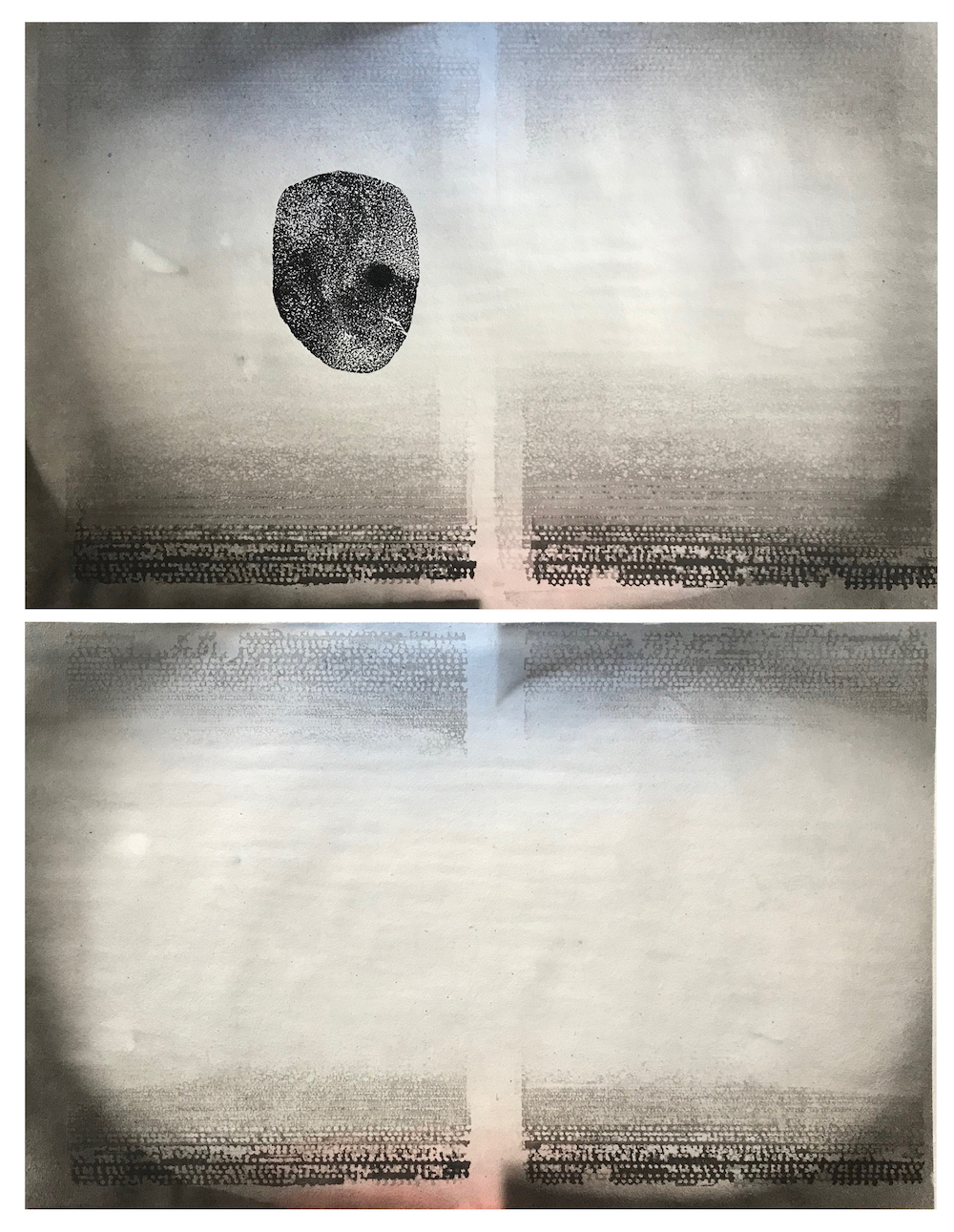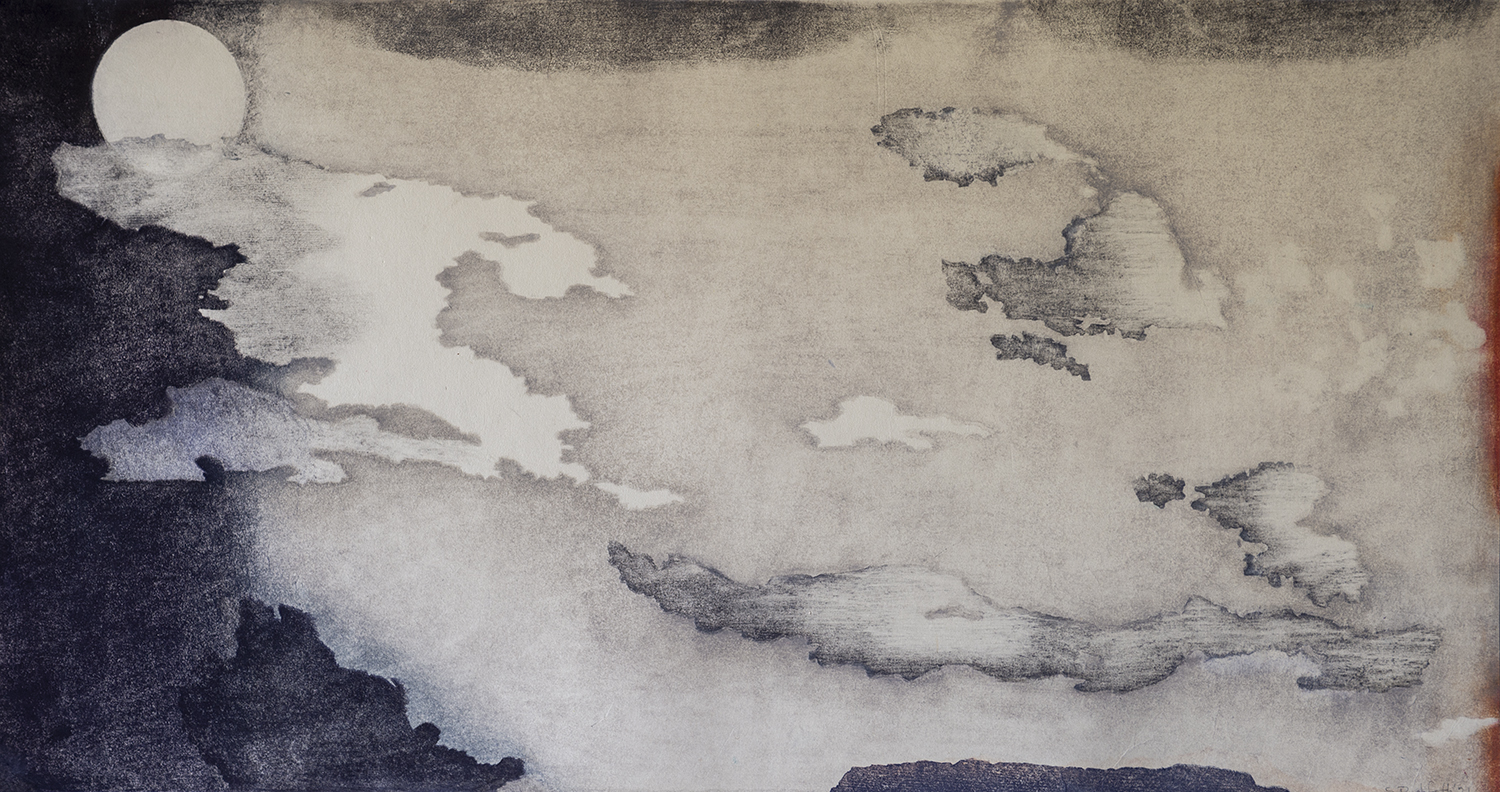
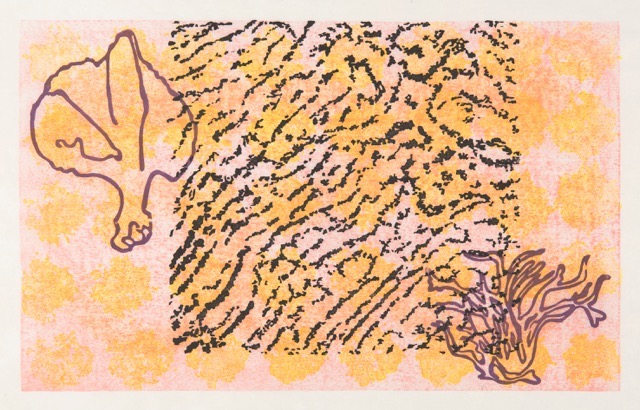

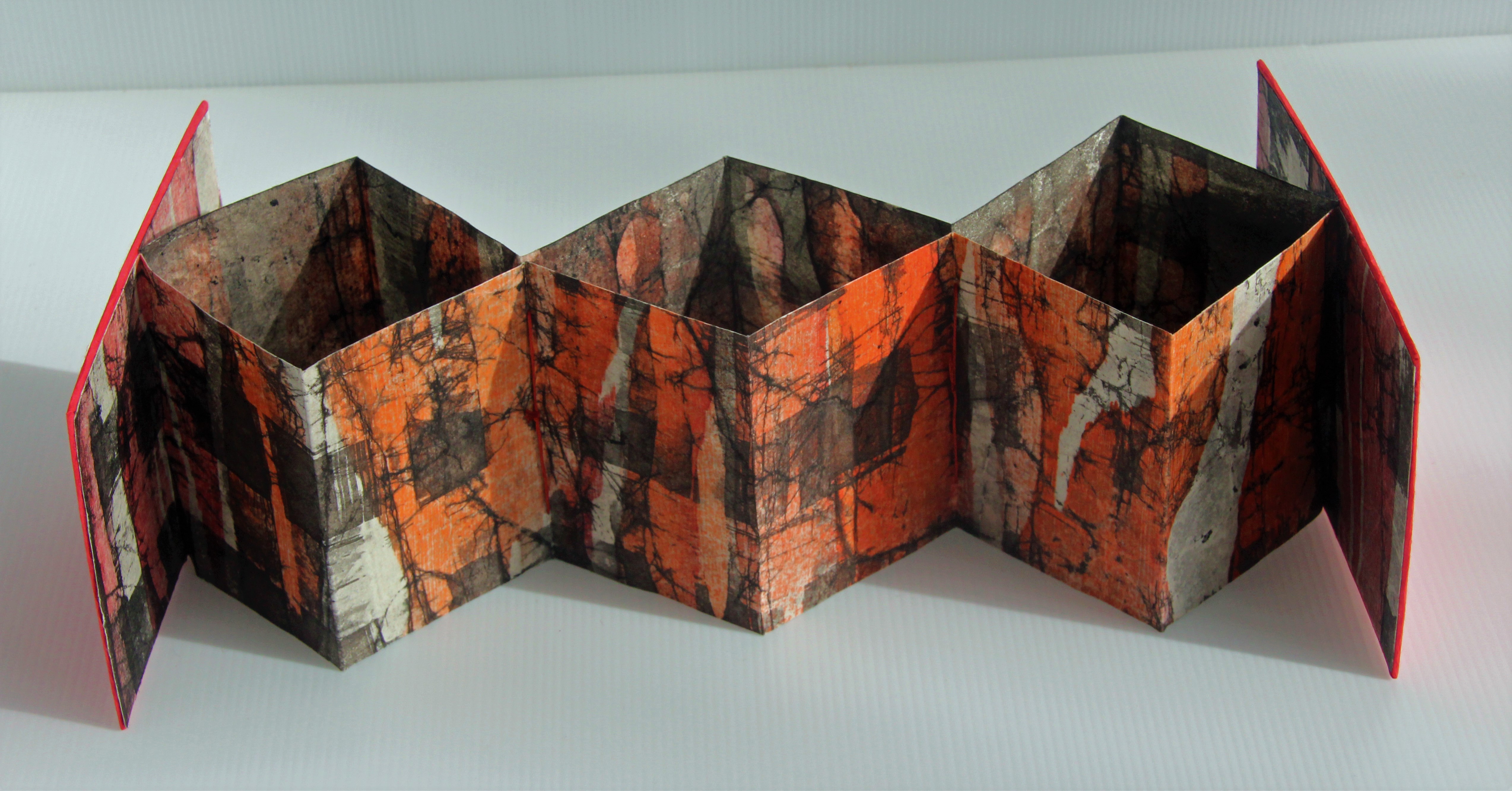
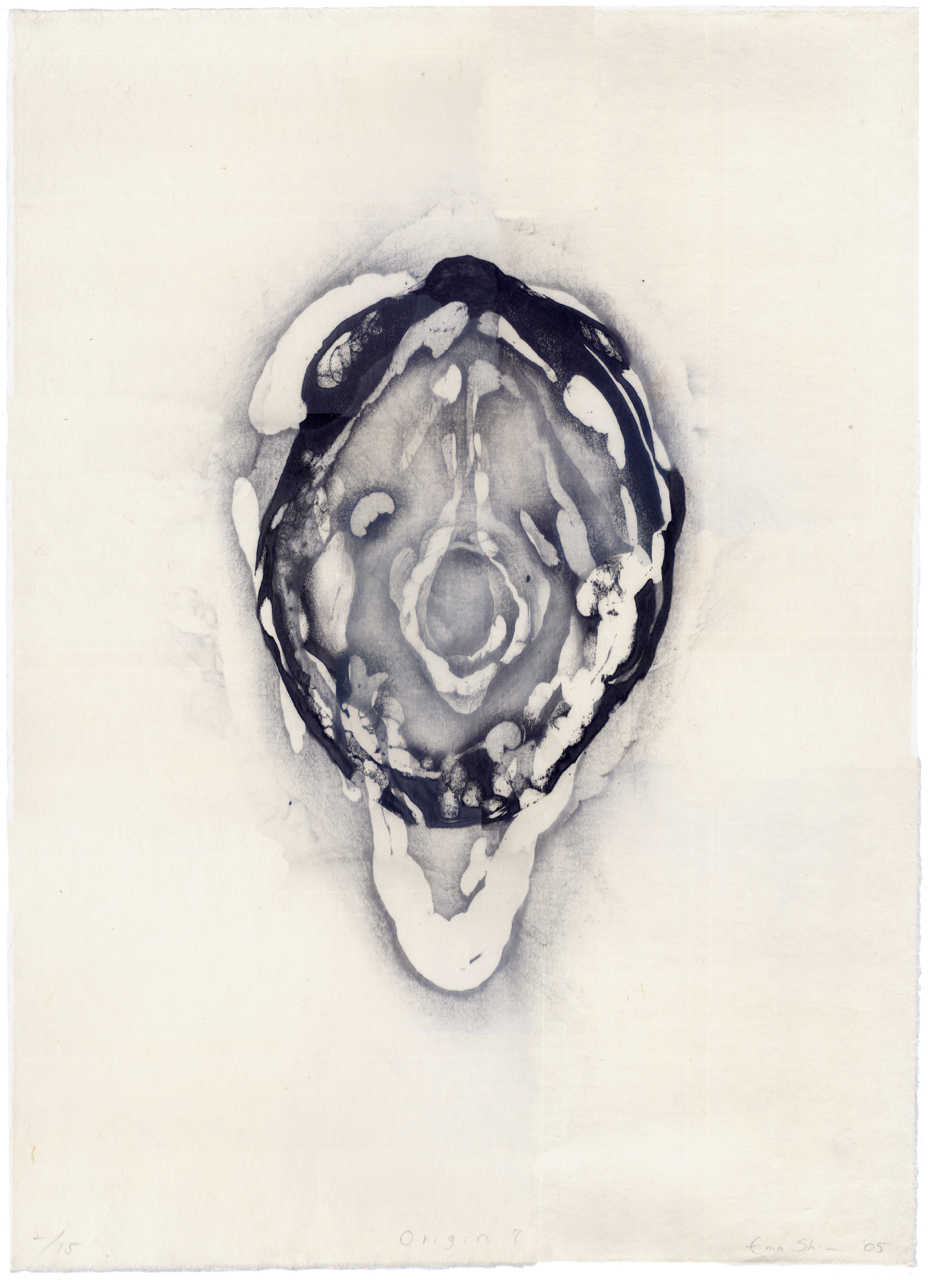
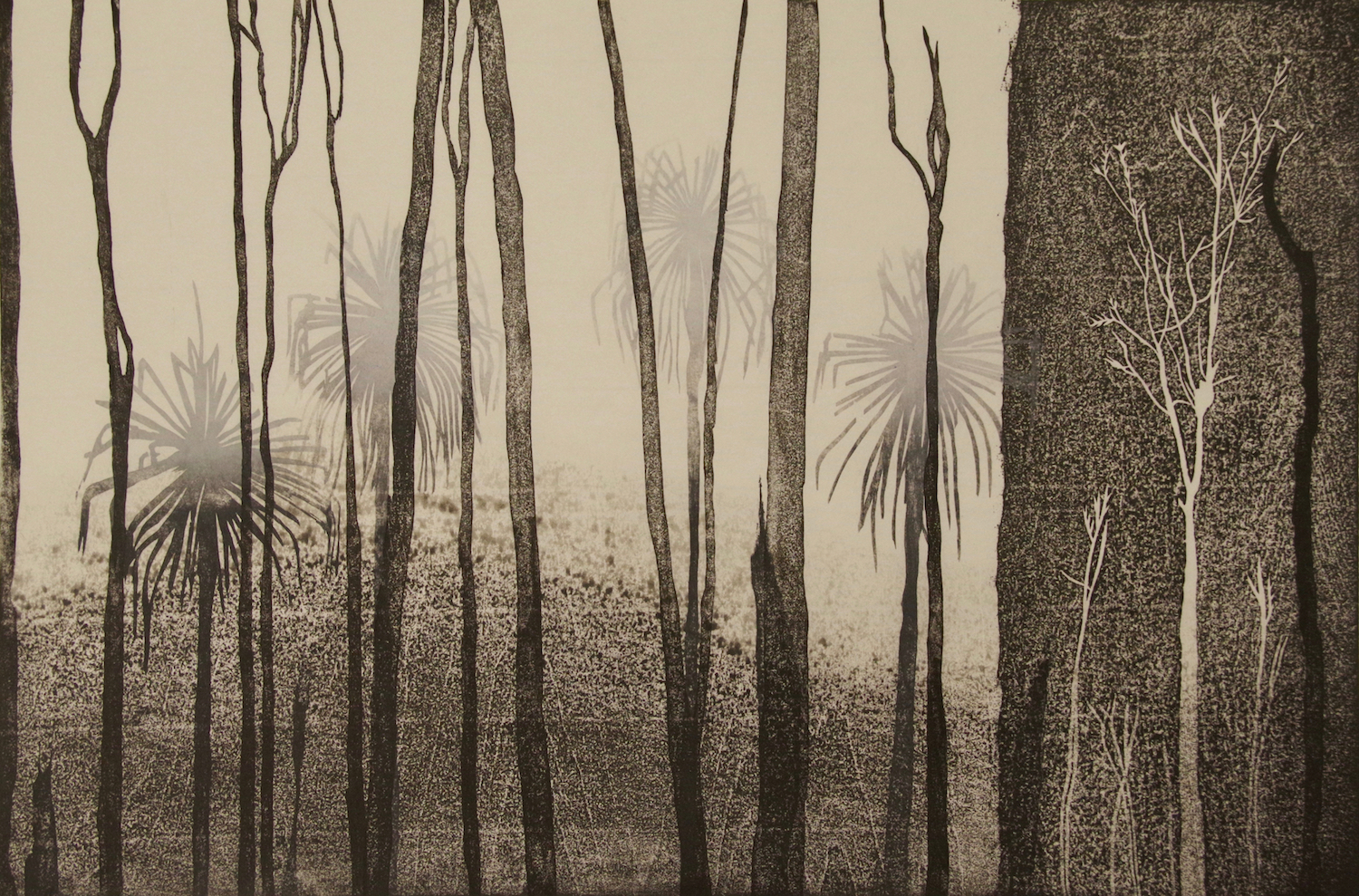
From top:
Neil Malone, Passing through 1-2, 2020, water-based mokuhanga, sumi stencil and wood engraving, 64 x 48.5 cm, unique state. Printed and created by Neil Malone. Reproduced with permission of the artist.
Susan Rushforth, Passing Clouds VII, 2021, woodblock print using water-based pigments on handmade Japanese Kozo paper, 35 x 70 cm, unique state. Reproduced with permission of the artist.
Deborah Metz, Sea Sponge Shapes with Eroded Rock Face Pattern, 2021, four-block mokuhanga, 40 x 57 cm, edition varied. Reproduced with permission of the artist.
Roslyn Kean, Winter Courtyard Shadows, 2021, multi-block mokuhanga with gold leaf, 76 x 56 cm, U/S. Reproduced with permission of the artist.
Trish Yates, Forest Glow, 2021, woodblock, wax, sumi ink, double backed accordion style artist’s book, 11 x 15 x 26 cm, unique state. Reproduced with permission of the artist.
Ema Shin, Origin #7, 2005, water-based woodblock print with sumi, nishinouchi washi, 55 x 40 cm, edition of 15. Reproduced with permission of the artist.
Jacqueline Gribbin, Hot Burn I, 2021, water-based woodblock print with sumi on Tosa Kozo, paper size 44 x 58.5 cm, image size 30 x 45.2 cm, A.P. Reproduced with permission of the artist.
Today, 1 December 2021, the Fourth International Mokuhanga Conference (IMC) opens in Nara, Japan after originally being scheduled for 2020. Due to the ongoing pandemic, the conference has been reorganised as a hybrid event, with a reduced physical conference in Nara and a worldwide virtual conference across three time zones.
The theme of the conference is sumi, the black ink traditionally used in mokuhanga (water-based woodblock printmaking) and calligraphy. Nara is renowned as a centre for the production of sumi and historically is where monochrome woodblock printmaking started being used as a form of communication.
Alongside three days of paper presentations, the event features the International Juried Exhibition, Sumi-Fusion as well as several satellite exhibitions, which include Australia-based artists. Eight artists’ works from Australia were selected for the International Juried Exhibition: Jolanta Ewart, Roslyn Kean, Neil Malone, Deborah Metz, Marilla Price, Susan Rushforth, Kay Watanabe and Trish Yates.
Melbourne-based artist Neil Malone, was Head of the Printmaking Department at the VCA until 2013, and was instrumental in introducing his students to mokuhanga at the college. His practice includes, painting, drawing and printmaking and exudes a tactile quality through his use of wood engraving, mokuhanga and etching.
Of his print Passing through 1-2, selected for the International Juried Exhibition, he states that it is,
‘…a combination of east and west oil and water. Traditionally it’s said they don’t mix, this is the basis of much of printmaking and it may be true of tourism as well, particularly of cultural tourism.
This work addresses this and uses European oil based Wood Engraving, Japanese water based Mokuhanga and atmospheric Sumi ink to travel through a linear space, embracing time and distance, with the understanding that it is all a misunderstanding.’
Susan Rushforth studied Japanese woodblock printing and sumi brushwork under two masters in Kyoto, and later studied mokuhanga and papermaking under Akira Kurosaki at Kyoto Seika University. Her strong grounding in these techniques is conveyed through her works where one can see the affinity she has with her materials: the softness of the ink on the washi and the ability to pull up the wood grain. She states,
‘Passing Clouds VII is an exploration of the concept of fluidity, in the moving forms of the clouds and the changing phase of the moon. These elements of the atmosphere and the cosmos express the transient qualities of nature.
The edges of the cosmological element of the moon are hard and revealed by light, whilst the sky, clouds and shadows as part of the atmosphere, are ever-changing elements while their perceived edges, are softer and ephemeral. The fragility of these edges, ever-changing, is subject to pressures of climate and light, which create an interplay of layers. The source of reflective light at the edge of this print, suggests the phenomena of sunrise and the passing of time: from night to daybreak.
The edges of the elements are fragile and fluid by nature. They also dissolve, blur and bleed in an ever-changing interplay. This is reflective of living in our current time of instability and uncertainty.’
Another artist who looks to her environment as a source to inform her work is Canberra-based Deborah Metz. Either when kayaking, snorkelling or walking on the beach, Metz is fascinated by ‘underwater gardens’ and the sponges, seaweeds and corals that inhabit them.
In Sea Sponge Shapes with Eroded Rock Face Pattern, Metz has created a work, which is a direct and physical response to her environment. She states that rubbings (frottage) of eroded rocks ‘created by erosion of wave action…over thousands of years…contrasted with the shapes of soft sea sponges, which actually were once wafting about in the ocean, is the huge intrigue for me’. Through her rubbings, observational drawings of sea sponges and stamps of cross sections of dried cucumber sea sponge, she has created a deceptively simple mokuhanga print of many layers, textures and forms.
Roslyn Kean’s Winter Courtyard Shadows, maximises and enhances the qualities that can be achieved with sumi and its wide-ranging tonalities of blacks and greys. Kean does this in an incredibly complex and technically accomplished manner, which is offset by the light of the gold leaf. The image displays Kean’s mastery of the technique of mokuhanga and astute knowledge of the characteristics of sumi. She quotes the writings In Praise of Shadows by the 20th Century Japanese author Jun’ichirō Tanizaki, ‘We find beauty not in the thing itself but in the patterns of shadows, the light and the dark, the one thing against another creates…..Were it not for shadows, there would be no beauty.’
Trish Yates’ double-sided accordion artist’s book was among seventeen books to be selected for Mokuhanga Ehon International Book Exhibition, Kyoto, one of the satellite exhibitions in the conference. Her local bushland is central to her practice, and this book also references bush fires with its strong oranges and blacks. The style of the book ‘enables the viewer to see all the sides and through the middle. The wax made the paper transparent so that when placed in light, the underlying colours glow as in sunlight’.
Osaka is the site of two satellite exhibitions, Noir Kuro comprising a portfolio of prints by fourteen artists and (Th)inking Black comprising eight artists, including Jacqueline Gribbin and Ema Shin. The works explore the colour black while using mokuhanga.
Ema Shin is a tapestry, textile and printmaking artist, whose delicate prints Origin #7 and Origin #8 allude to her ‘interest in anatomical forms that are revealed in X-rays and CT scans and (her) research into plant structures has resulted in these layered black and white compositions’. Printing on both sides of the lightweight washi, allows for ‘numerous soft shades of grey that allude to the gentle and soft nature of human bodies and plant life’.
Jacqueline Gribbin’s Hot Burn I and Hot Burn II, reference a harsher environment – that of burnt bushland near her home in the Northern Territory. But whilst the bush is burnt black, the aftermath also reveals smoke from still burning embers, which hovers and floats through the air, revealing soft silhouettes of the native sand palms.
—
The International Juried Exhibition can be seen online at:
https://2021.mokuhanga.org/schedule/exhibition-artwork/
(Th)inking Black exhibition:
https://2021.mokuhanga.org/2021/10/04/imc-satellite-exhibitions-at-gallery-ami-kanoko-osaka/
http://ami-kanoko.com/exhibition/mokuhanga-and-sumi
Mokuhanga Ehon International Book Exhibition:
https://2021.mokuhanga.org/2021/10/04/mokuhanga-ehon-international-book-exhibition-kyoto/
—
Join the PCA and become a member. You’ll get the fine-art quarterly print magazine Imprint, free promotion of your exhibitions, discounts on art materials and a range of other exclusive benefits.

